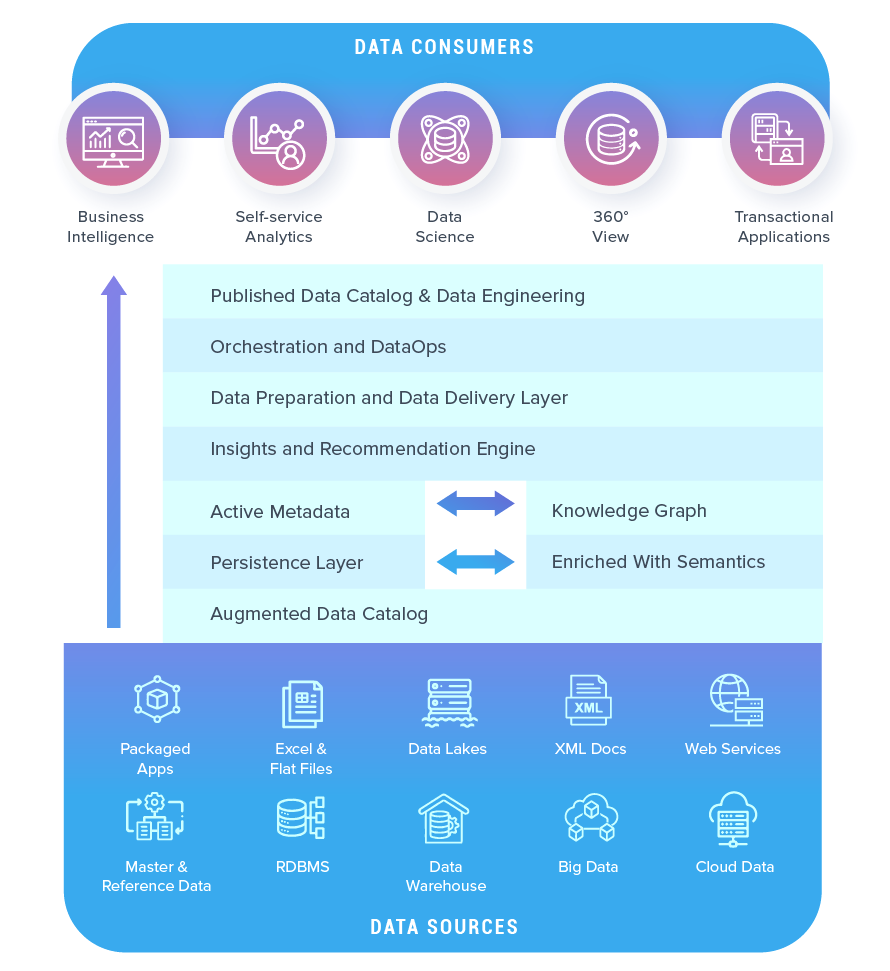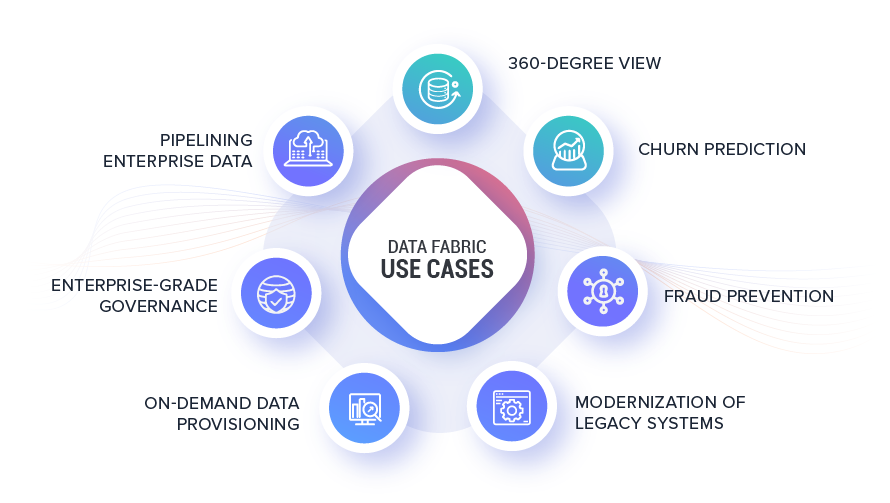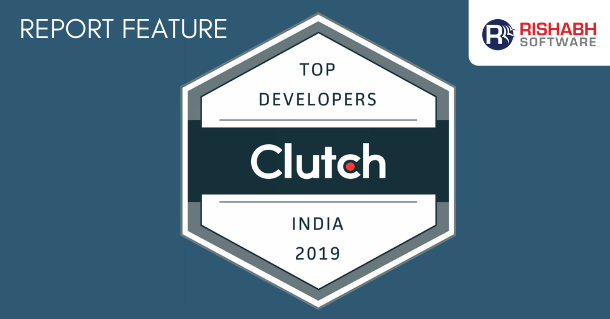Data-driven enterprises have an edge over others. And, now with the emergence of cloud computing, IoT, mobility, and other factors, a massive amount of information is pouring in from several sources. As a result, managing different data types scattered across disparate repositories is getting downright challenging.Enterprise Data Fabric has emerged as a viable strategy for frictionless access & sharing of dynamic, distributed, and diverse records. It is a robust solution to low-value and high-cost integration cycles and the rising demand for real-time information sharing.
This article will walk you through the what, why & how of the data fabric.
What Is Data Fabric?
It is a converged platform that uses a network-based architecture for handling documents instead of point-to-point connections. This enables an integrated layer of data (fabric) between the different sources, orchestration, analytics, applications, and insights.
Think of it as an autonomous car in two different scenarios!
- In the first, the driver is highly attentive and focused on the route. Here, the autonomous feature of the car has a negligible role to play.
- In the second, the driver is somewhat sluggish and lost. The car instantly switches to a self-driving mode & makes all the needed course corrections.
Both the situations show how data fabric works. It constantly tracks data pipelines as a passive observer initially. Then it recommends options that are more efficient and productive. When both the data (driver) and the autonomous mode (Machine learning technology) are accustomed to repeated situations, they supplement each other by automating improvisational functions that otherwise take up too much time and effort. This leaves the leadership free to focus on business transformation.
Why Data Fabric?
It brings businesses the flexibility to adapt the infrastructure in response to evolving technology needs. This makes it easy to connect different infrastructure endpoints with a centralized information management framework for enhanced business agility and speed. With a data fabric solution, companies can build a data environment that efficiently monitors and manages information across apps, users and environments.
For instance, a small business can invest in a low-cost cloud platform until it expands and needs a highly flexible and larger storage solution. It can leverage the elasticity of Data Fabric to deploy an infrastructure that best suits the nature of information and long-term business needs. The document management functionality will then apply across deployments to overcome all the barriers that previously restricted access and processing of records in a distributed environment.
Data Fabric Benefits for Businesses
- Manage on-premises, cloud, & hybrid environments simultaneously to drive business agility
- Use pre-designed modules to connect different sources seamlessly and accelerate data delivery
- Enhance data preparation, quality & governance capabilities to avoid costly noncompliance fines
- Improve integration between disparate apps and sources and map data for quick and easy analysis
- Gain a real-time view of any business entity to reduce customer churn, mitigate risk, personalize offerings and achieve goals
- Reduce the cost of operating, scaling, maintaining, and modernizing legacy systems
Data Fabric Architecture

A comprehensively designed data fabric architecture is extensible and supports distributed multi-cloud, massive scale, and on-premise as well as hybrid deployments.
As depicted in the above image, information is provisioned from different sources to consumers, it is indexed, refined to extract insights, prepared, distributed, orchestrated, and engineered.
Sources range from legacy systems and excel files to packaged apps and cloud environments.
Data consumers include data analysts, data scientists, sales & marketing analysts, data privacy specialists, cloud architects, and more.
Data Fabric Vs Data Lake
Data fabric adds a semantic layer to data lake to ease the process of the modeling data environment, reliability, and governance. Data lakes leverage a leading-edge framework that helps simplify the management and reuse of information for new apps, AI workloads, and analytics. Data fabric is the preferred architecture for high-volume, large-scale, real-time operational use cases.
Data fabric can prepare reliable records for lakes and warehouses that generate insights for use in real-time. As data fabric supports heterogeneous locations, it streamlines management across disparate repositories. Therefore, it does not replace a data lake; rather they’re best harnessed together!
Data Fabric Vs Data Mesh
Both data fabric and data mesh enable an architecture that facilitates a connected experience across a complex, distributed data landscape. While both deliver data products, data mesh enables product thinking as a major design principle. As a consequence, details are provisioned and maintained just like other products using a data mesh.
Data mesh leverages automation to uncover, connect, identify, recommend and deliver assets based on a rich metadata foundation. Both data fabric & mesh have a special seat at the big data table. In the search for architectures & architectural concepts to support your big data initiatives, it all boils down to knowing what works best for your unique needs.
Modern Data Management Challenges
An average enterprise looks drastically different from what it was a decade ago. The sheer volume, variety, and veracity of information have completely changed the approach to data management. With the emergence of cloud solutions, many businesses have moved from using a single software to leveraging SaaS growth for speedy development. Companies are now leveraging APIs to programmatically run digital marketing campaigns, CRMs to manage contacts, ticketing systems to track support issues, and making the most of automation for inventory and billing.
The typical documents and records that a business generates and consumes is scattered across a myriad of sources, all of which need to be integrated, maintained, and synced to maximize their benefits. This data management ecosystem gives rise to certain challenges:
Data Access
With several distributed systems, it’s difficult to control access to certain resources, especially at different security levels.
Data Security
With information being stored across different locations and accessed over multiple endpoints, keeping the APIs, apps & endpoints secure invites massive overhead.
Regulatory Compliance
Working with a disparate, siloed system makes it challenging to keep up with the regulatory standards that apply to storing, sharing & distribution of business information.
Technology Lock-ins
Once a data ecosystem is deployed on certain software, it is difficult to integrate new sources or transform the existing ones, blocking the ability of a business to act on info faster.
Data Fabric Core Capabilities
A comprehensively designed data fabric solution should typically offer the following capabilities:
- Transparent Data Management: The ability to stay on top of information availability, reliability, responsiveness, and risk in a single, unified workspace.
- Unified Data Semantics: One workspace for all document types makes it easy to define the business purpose & establish a single source of truth for a cohesive analytics experience.
- Autonomous Data Engineering: Just-in-time query optimization for speed & usage that can predict consumer needs in one platform reduces the hassles of knowledge management.
- Centralized Governance: A meticulously formulated security policy to distribute access is consistently applied to all document types – whether they are on-premises, in the cloud, multi-cloud, or hybrid.
- Application & Platform Agnostic: The ability to rapidly integrate with BI & ML applications of choice for consumers and managers alike.
- No Need to Move or Copy Data: Intelligent data virtualization to ensure an end-to-end representation of information from several siloed, disparate sources without having to move or copy the data.
- A future-ready Infrastructure: The ability to integrate new infrastructure deployments and re-engineer legacy solutions without disrupting the existing deployments and documentation types.
Data Fabric Use Cases
Data-intensive businesses are driven by a broad spectrum of real-time applications needing a scalable, high-speed architecture that is designed to support millions of transactions simultaneously. Practical examples include:

360-degree View
Gain a holistic view of your customer data from all touchpoints – interactive voice response (IVR), Self-service portal (mobile or web), customer relationship management software (CRM), service chatbots, and field service technicians.
Churn Prediction
Leverage metadata KPIs to enable ML algorithms to learn with time and generate advanced, accurate, and reliable predictions regarding information management & integration.
Fraud Prevention
Safeguard sensitive credit and debit card information with end-to-end encryption and multi-factor authentication of the original information to avoid potential breaches.
Modernization of Legacy Systems
Safely move records from existing legacy systems into the data fabric and then use it as the database of record for newly deployed applications.
On-demand Data Provisioning
Build a data warehouse (DWH) and automate the delivery of anonymous test data to CI/CD pipelines and testers while ensuring complete integrity.
Enterprise-Grade Governance
Address current & future regulations with an agile workflow and an information automation solution that orchestrates compliance across systems, apps, reports & documents.
Pipelining Enterprise Data
Enable engineers to prepare & deliver accurate & reliable records into data lakes and warehouses from all sources – rapidly and at scale.
How Rishabh Can Help You Put Big Data Fabric into Action
For over a decade now, Rishabh has been enabling global enterprises with data management tools such as MS Master Data services, Kafka, Apache Spark & more that help cut costs, ensure compliance and streamline data management at scale. Our Data Fabric as a service offering is inclusive of centralized, cloud-based enterprise-grade integrations that seamlessly and securely share business information between third-party apps and systems.
From strategic consultation and architecture analysis to design implementation and integrations – everything aims to align systems, apps, and documents to boost business agility. We use AWS and Azure Integration Services, BizTalk & Mulesoft platforms to drive efficiency & consistency when connecting on-premises systems with cloud-based apps.











 30 Min
30 Min


